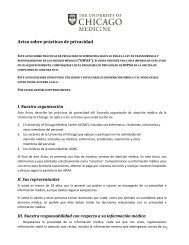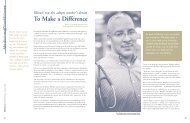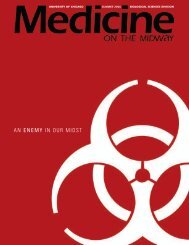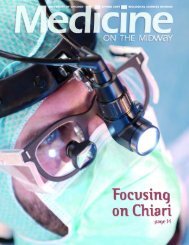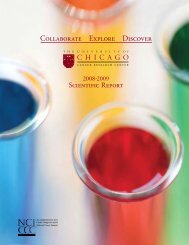Pureed Diet - University of Chicago Medical Center
Pureed Diet - University of Chicago Medical Center
Pureed Diet - University of Chicago Medical Center
You also want an ePaper? Increase the reach of your titles
YUMPU automatically turns print PDFs into web optimized ePapers that Google loves.
Cream Soup 3 ½ cupTomato Soup 2 ½ cupPudding 3 ½ cupSugar-Free Gelatin 2 ½ cupSugar Free Popsicles 0 1 svgSugar Free Fudgsicles 2 1 svgFarina 2.5 ¾ cupGrits 3.5 1 cupOatmeal 3 ½ cupTo help you monitor the amount <strong>of</strong> protein you eat, it is important for you to keepprecise daily food records. Use food labels and the handouts we have provided tocalculate the amount <strong>of</strong> protein (grams) per serving.Tips to Increase Your Protein Intake* Double strengthen your milk (add 2.5-3 tablespoons <strong>of</strong> non-fat powdered milk per 1cup milk). If you have lactose intolerance, try Lactaid® or Dairy Ease®, which contain enzymesto help digest your milk. You may also try soy or rice milk. Add non-fat powdered milk or a protein supplement <strong>of</strong> your choice to any liquid orpureed food (cottage cheese, soup, yogurt, hot cereal, Sugar Free Carnation InstantBreakfast® (4g protein per packet). Sip on a protein drink between meals.3. FatsA moderate fat diet is recommended after surgery. Avoiding greasy, fried, high-fatfoods is important for your health and to achieve your weight loss goals. Fat alsodelays gastric emptying and nay contribute to feeling full for a prolonged period <strong>of</strong>time, and potentially lead to vomiting.It is recommended that you choose low-fat dairy products (milk, cheese, cottagecheese, yogurt). When choosing foods, the majority <strong>of</strong> the fat should come frommonounsaturated (canola, olive, and peanut oils, avocados) and polyunsaturated(corn, safflower, peanut, soybean and sunflower oils) vs. saturated (butter and otheranimal products) sources. Foods should be baked, broiled, or grilled. Remove theskin <strong>of</strong>f poultry before eating it. Choose to eat fish at least three times per week.Foods such as nuts and seeds are healthy snacks due to their healthy fat andprotein content, but are also high in calories and should be eaten in small portions.Trans fatty acids (TFA’s) are formed during the process <strong>of</strong> hydrogenation, whichturns liquid fats (oils) into a solid substance, such as margarine and shortening.Foods made from TFA’s are abundant in the American diet because they allowfoods to stay fresh on grocery shelves for a long time. Typical foods that containTFA’s are: doughnuts, french fries, cookies, crackers, snack chips, and many othercommercially prepared snacks and baked good. TFA’s should be avoided, as theyresult in unfavorable changes in your blood cholesterol levels. Humans do notrequire any trans fats in their diets, therefore, the goal for TFA consumption is ZEROgrams daily.Copyright © 2008 <strong>University</strong> <strong>of</strong> <strong>Chicago</strong> <strong>Medical</strong> <strong>Center</strong>




